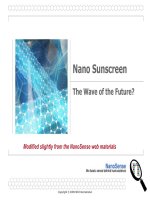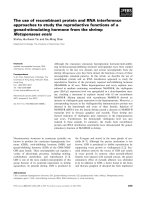To study the antimicrobial properties of honey on common microorganisms
Bạn đang xem bản rút gọn của tài liệu. Xem và tải ngay bản đầy đủ của tài liệu tại đây (286.86 KB, 8 trang )
Int.J.Curr.Microbiol.App.Sci (2019) 8(9): 114-121
International Journal of Current Microbiology and Applied Sciences
ISSN: 2319-7706 Volume 8 Number 09 (2019)
Journal homepage:
Original Research Article
/>
To Study the Antimicrobial Properties of Honey
on Common Microorganisms
P.S. Aswin and P. Neelusree*
Department of Microbiology, Saveetha Medical College and Hospital, India
*Corresponding author
ABSTRACT
Keywords
Coorg honey,
Kashmir Herbal
honey, Natural
Kashmir honey,
Dabur honey and
Manuka honey
Article Info
Accepted:
04 August 2019
Available Online:
10 September 2019
Honey is defined as a natural sweet substance which is produced from the floral nectar by
honeybees. Honey is well-known for its antimicrobial activities and it has been reported to
have antibacterial effect to about 60 species of bacteria and antifungal properties as well.
Honey has been used to inhibit these bacteria as well as to prevent and treat skin and other
infections. Honey as a tropical antibacterial agent for treatment of infected wounds. The
natural ingredients of honey show different activities against various microorganisms.
Honey has an increasing effect on the levels of anti-oxidants, iron and rare elements in
blood. The antimicrobial property is also based on UMF of that honey taken showed that
honey had a more pronounced inhibitory effect (85.7%) on Gram negative bacteria
(Pseudomonas aeruginosa, Enterobacter spp., Klebsiella) in comparison to commonly
used antimicrobial agents. To analyse the establishment activity of different honey (Coorg
honey, Kashmir Herbal honey, Natural Kashmir honey, Dabur honey and Manuka honey)
on various organisms like Acinetobacter, Coagulase Negative Staphylococcus (CONS),
Methicillin resistant Coagulase Negative Staphylococcus (MRCONS), Methicillin
Sensitive Staphylococcus aureus (MSSA), Methicillin resistant Staphylococcus aureus
(MRSA), Enterococcus, Klebsiella, E. coli, ATCC Staphylococcus aureus, Pseudomonas
With various concentration (10%, 20%, 50% ). Among all the brands of honey tested
Manuka honey was effective against ever against all the organisms tested at 50%
concentration. Similarly Dabur Honey was effective against all organisms at 50%. In
conclusion, though Manuka honey is the best for treating microorganisms, it is not
affordable to low socioeconomic people, because of its high cost. Still Dabur Honey can
be an alternative topical agent to treat burns wound infections which are cost effective.
Honey exhibits antimicrobial property against gram negative and few gram positive
organisms.
Introduction
Honey is defined as a natural sweet substance
which is produced from the floral nectar by
honeybees. Honey is well-known for its
antimicrobial activities and it has been
reported to have antibacterial effect to about
60 species of bacteria and antifungal
properties as well [1]. Honey has been used to
inhibit these bacteria as well as to prevent and
114
Int.J.Curr.Microbiol.App.Sci (2019) 8(9): 114-121
treat skin and other infections [2]. Honey as a
tropical antibacterial agent for treatment of
infected wounds. [3]. The natural ingredients
of honey show different activities against
various microorganisms. Honey has an
increasing effect on the levels of anti-oxidants,
iron and rare elements in blood [4]. The
antimicrobial property is also based on UMF
of that honey taken [5] showed that honey had
a more pronounced inhibitory effect (85.7%)
on Gram negative bacteria (Pseudomonas
aeruginosa, Enterobacter spp., Klebsiella) in
comparison to commonly used antimicrobial
agents. The use of honey as a drug for the
treatment of disease dates back to 2100-2000
BC. For instance, pale honey was described by
Aristotle (384-322 BC) as being ‗‗good for
sore eyes and wounds‖ [6]. A possible reason
behind its activity relies on its ability to
generate hydrogen peroxide by the beederived enzyme glucose oxidase [7].
Materials and Methods
The present prospective study was carried out
in the department of Microbiology, Saveetha
Medical college. This study was done to
analyse the establishment activity of different
honey
on
various
organisms
like
Acinetobacter,
Coagulase
Negative
Staphylococcus (CONS), Methicillin resistant
Coagulase
Negative
Staphylococcus
(MRCONS),
Methicillin
Sensitive
Staphylococcus aureus (MSSA), Methicillin
resistant Staphylococcus aureus (MRSA),
Enterococcus, Klebsiella, E. coli, ATCC
Staphylococcus aureus, Pseudomonas. Each
of these organisms was treated with Five
different honey (Coorg honey, Kashmir
Herbal honey, Natural Kashmir honey, Dabur
honey and Manuka honey) with various
concentration of 50%, 20% and 10%.
50%. To a 16ml of sterilised nutrient broth I
added 4ml of honey to prepare a concentration
of 20%. To a 18ml of sterilised nutrient broth I
added 2 ml of honey to prepare a
concentration of 10%. A loopful of each
microorganism (Acinetobacter, Coagulase
Negative Staphylococcus (CONS),Methicillin
resistant Coagulase Negative Staphylococcus
(MRCONS),
Methicillin
Sensitive
Staphylococcus aureus (MSSA),Methicillin
resistant Staphylococcus aureus (MRSA),
Enterococcus, Klebsiella, E. coli, ATCC
Staphylococcus aureus, Pseudomonas) is
mixed to each concentration 10% 20% and
50% concentration of different types of honey
(Coorg honey, Kashmir Herbal honey, Natural
Kashmir honey, Dabur honey and Manuka
honey) respectively and is incubated
overnight. After overnight incubation, it is
streaked onto Muller Hinton Agar and
incubated at 37*c for 24 hours. After 24 hours
incubation the plates were observed for the
growth on each concentration.
Results and Discussion
Prospective study carried out in Department of
Microbiology, Saveetha Medical College to
analyse the antibacterial activity of various
brands of honey (Coorg honey, Kashmir
Herbal honey, Natural Kashmir honey, Dabur
honey and Manuka honey) on various
organisms
[Acinetobacter,
Coagulase
Negative Staphylococcus (CONS),Methicillin
resistant Coagulase Negative Staphylococcus
(MRCONS),
Methicillin
Sensitive
Staphylococcus aureus (MSSA), Methicillin
resistant Staphylococcus aureus (MRSA),
Enterococcus, Klebsiella, E. coli, ATCC
Staphylococcus aureus, Pseudomonas] at
various concentrations 10%,20% and 50%.
Coorg Honey
Preparation of honey solution
To a 10 ml of sterilised nutrient broth I added
10ml of honey to prepare the concentration of
Antibacterial
activity
against
various
organisms
[Acinetobacter,
Coagulase
Negative Staphylococcus (CONS), Methicillin
115
Int.J.Curr.Microbiol.App.Sci (2019) 8(9): 114-121
resistant Coagulase Negative Staphylococcus
(MRCONS),
Methicillin
Sensitive
Staphylococcus aureus (MSSA), Methicillin
resistant Staphylococcus aureus (MRSA),
Enterococcus, Klebsiella, E. coli, ATCC
Staphylococcus
aureus,
Pseudomonas]
analysed at 10%, 20% and 50%
concentrations. It showed 50% concentration
was effective in killing Enterococcus and
CONS. None other 10% nor 20%
concentration was effective against other
organisms tested (As shown in Fig. 1).
Kashmir herbal honey
Antibacterial
activity
against
various
organisms
[Acinetobacter,
Coagulase
Negative Staphylococcus (CONS),Methicillin
resistant Coagulase Negative Staphylococcus
(MRCONS),
Methicillin
Sensitive
Staphylococcus aureus (MSSA), Methicillin
resistant Staphylococcus aureus (MRSA),
Enterococcus, Klebsiella, E. coli, ATCC
Staphylococcus
aureus,
Pseudomonas]
analysed at 10%, 20% and 50%
concentrations. It showed 50% concentration
was effective against MRSA and MSSA; and
20% concentration was found to be effective
against CONS. This honey was found
ineffective against other organisms (As shown
in Fig. 2).
Natural Kashmir honey
Antibacterial
activity
against
various
organisms
[Acinetobacter,
Coagulase
Negative Staphylococcus (CONS), Methicillin
resistant Coagulase Negative Staphylococcus
(MRCONS),
Methicillin
Sensitive
Staphylococcus aureus (MSSA), Methicillin
resistant Staphylococcus aureus (MRSA),
Enterococcus, Klebsiella, E. coli, ATCC
Staphylococcus
aureus,
Pseudomonas]
analysed at 10%, 20% and 50%
concentrations. It showed 50% concentration
was effective against CONS. None other
concentration was effective against other
organisms (Fig. 3).
Dabur honey
Antibacterial
activity
against
various
organisms
[Acinetobacter,
Coagulase
Negative Staphylococcus (CONS),Methicillin
resistant Coagulase Negative Staphylococcus
(MRCONS),
Methicillin
Sensitive
Staphylococcus aureus (MSSA), Methicillin
resistant Staphylococcus aureus (MRSA),
Enterococcus, Klebsiella, E. coli, ATCC
Staphylococcus
aureus
Staphylococcus
(MRCONS)
Methicillin
Sensitive
Staphylococcus aureus (MSSA), Methicillin
resistant Staphylococcus aureus (MRSA),
Enterococcus, Klebsiella, E. coli, ATCC
Staphylococcus aureus, Pseudomonas] (As
shown is Fig. 4).
Manuka honey
Antibacterial
activity
against
various
organisms
[Acinetobacter,
Coagulase
Negative Staphylococcus (CONS), Methicillin
resistant Coagulase Negative Staphylococcus
(MRCONS),
Methicillin
Sensitive
Staphylococcus aureus (MSSA), Methicillin
resistant Staphylococcus aureus (MRSA),
Enterococcus, Klebsiella, E. coli, ATCC
Staphylococcus
aureus,
Pseudomonas]
analysed at 10%, 20% and 50%
concentrations.
It showed 50% was effective against all
microorganisms [Acinetobacter, Coagulase
Negative Staphylococcus (CONS), Methicillin
resistant Coagulase Negative Staphylococcus
(MRCONS),
Methicillin
Sensitive
Staphylococcus aureus (MSSA), Methicillin
resistant Staphylococcus aureus (MRSA),
Enterococcus, Klebsiella, E. coli, ATCC
Staphylococcus aureus, Pseudomonas]; and
20% was effective against Acinetobacter,
Coagulase Negative Staphylococcus (CONS),
116
Int.J.Curr.Microbiol.App.Sci (2019) 8(9): 114-121
Methicillin resistant Coagulase Negative
Staphylococcus
(MRCONS),
Methicillin
Sensitive,
Staphylococcus
aureus
(MSSA),Methicillin resistant Staphylococcus
aureus (MRSA), Enterococcus, Klebsiella, E.
coli.; and 10% was effective against
Acinetobacter. One of the commonest multi
drug resistant (MDR) organism in hospital
setting (Acinetobacter) is killed by 10%, 20%
and 50% concentration of Manuka Honey (As
shown in Fig. 5).
Prospective study carried out in Department of
Microbiology, Saveetha Medical College to
analyse the antibacterial activity of various
brands of honey (Coorg honey, Kashmir
Herbal honey, Natural Kashmir honey, Dabur
honey and Manuka honey) on various
organisms
[Acinetobacter,
Coagulase
Negative Staphylococcus (CONS), Methicillin
resistant Coagulase Negative Staphylococcus
(MRCONS),
Methicillin
Sensitive
Staphylococcus aureus (MSSA), Methicillin
resistant Staphylococcus aureus (MRSA),
Enterococcus, Klebsiella, E. coli, ATCC
Staphylococcus aureus, Pseudomonas] at
various concentrations 10%,20% and 50%.
The antimicrobial properties of honey have
been known to humans for centuries [8].
Honey was used to treat infected wounds as
long ago as 2000 years before bacteria were
discovered to be the cause of infection. In c.50
AD, Dioscorides described honey as being
―good for all rotten and hollow ulcers‖. Honey
has been reported to have an inhibitory effect
to around 60 species of bacteria including
aerobes and anaerobes, gram-positives and
gram-negatives [9].
An antifungal action has also been observed
for some yeasts and species of Aspergillus and
Penicillium, as well as all the common
dermatophytes.
The current prevalence of antibiotic-resistant
microbial species has led to a re-evaluation of
the therapeutic use of ancient remedies,
including honey [10]. Aristotle (384-322 BC),
when discussing different honeys, referred to
pale honey as being ―good as a salve for sore
eyes and wounds‖ Natural honey consists
mainly of carbohydrates (about 82%), water
and other minor components. Those minor
ingredients include: proteins, minerals,
phytochemicals and antioxidants.
It has been reported that those minor
ingredients are the ones that are responsible
for medical and biological activities of honey
in the treatment of infections, burns, wounds
and ulcers. The honey sugars are mostly
fructose (38.2%) and glucose (31.2%), sucrose
concentration ranges between (0.7% and 1%),
disaccharides (approximately 9%) some
trisaccharides and higher saccharides [12].
Different types of honey possess different
efficacies and mechanisms against the same
type of bacteria, with Manuka Honey showing
the best performance. This is in accordance
with what has been reported by other authors
who used honey as an agent to inhibit biofilm
formation by S. aureus [13].
Manuka Honey contained the highest amount
of total phenolic compounds such as methyl
syringate which provides this honey with its
ability to scavenge potent superoxide free
radicals and, thus, exerts its antibacterial
activity [14].
In our study antibacterial activity of Manuka
honey was tested against various orgnisms
[Acinetobacter,
Coagulase
Negative
Staphylococcus (CONS),Methicillin resistant
Coagulase
Negative
Staphylococcus
(MRCONS),
Methicillin
Sensitive
Staphylococcus aureus (MSSA), Methicillin
resistant Staphylococcus aureus (MRSA),
Enterococcus, Klebsiella, E. coli, ATCC
Staphylococcus
aureus,
Pseudomonas]
analysed at 10%, 20% and 50%
117
Int.J.Curr.Microbiol.App.Sci (2019) 8(9): 114-121
concentrations. It showed 50% was effective
against all microorganisms [Acinetobacter,
Coagulase Negative Staphylococcus (CONS),
Methicillin resistant Coagulase Negative
Staphylococcus
(MRCONS),
Methicillin
Sensitive Staphylococcus aureus (MSSA),
Methicillin resistant Staphylococcus aureus
(MRSA), Enterococcus, Klebsiella, E. coli,
ATCC Staphylococcus aureus, Pseudomonas];
and 20% was effective against Acinetobacter,
Coagulase Negative Staphylococcus (CONS),
Methicillin resistant Coagulase Negative
Staphylococcus
(MRCONS),
Methicillin
Sensitive Staphylococcus aureus (MSSA),
Methicillin resistant Staphylococcus aureus
(MRSA), Enterococcus, Klebsiella, E. coli. and
10% was effective against Acinetobacter.
One of the commonest multi drug resistant
(MDR) organism in hospital setting
(Acinetobacter) is killed by 10%, 20% and
50% concentration of Manuka Honey.
Similar to few other studies done by Saad B.
Almasaudi et al., which showed Manuka
honey was effective at 10%, 20%, 50%
Concentration against MRSA and MSSA.
Fig.1 Antimicrobial activity of Coorg honey
Fig.2 Antimicrobial activity of Kashmir herbal honey
118
Int.J.Curr.Microbiol.App.Sci (2019) 8(9): 114-121
Fig.3 Antimicrobial activity of natural Kashmir honey
Fig.4 Antimicrobial activity of Dabur honey
Fig.5 Antimicrobial activity of Manuka Honey
119
Int.J.Curr.Microbiol.App.Sci (2019) 8(9): 114-121
In our study Manuka honey was found to be
effective against 50% Concentration of
Pseudomonas aeruginosa in contrary to few
other studies Aled E. L. Roberts et al., which
showed Manuka honey is effective against
10%,
20%,
50%
Concentration
of
Pseudomonas aerugenosa. This study shows,
Manuka. Honey can be used as an topical
agent in burns patients.
infected burns. Ann. Burns Fire
Disasters 20, 83.
Aiken, A., Karuri, D., Wanyoro, A., Macleod,
J., 2012. Interventional studies for
preventing surgical site infections in
sub-Saharan
Africa—a
systematic
review. Int. J. Surg. 10, 242–249.
Alsarra, I.A., 2009. Chitosan topical gel
formulation in the management of burn
wounds. Int. J. Biol. Macromol. 45, 16–
21.
Brady NF, Molan PC, Harfoot CG. The
sensitivity of dermatophytes to the
antimicrobial activity of manuka honey
and other honey. Pharm Sci 1997; 2: 13.
Efem SE. Recent advances in the
management of Fournier‘s gangrene:
French, V., Cooper, R.A., Molan, P.C., 2005.
The antibacterial activity of honey
against
coagulase-negative
staphylococci.
J.
Antimicrob.
Chemother. 56, 228–231.
Lu, J., Turnbull, L., Burke, C.M., Liu, M.,
Carter, D.A., Schlothauer, R.C.,
Whitchurch, C.B., Harry, E.J., 2014.
Manuka-type honeys can eradicate
biofilms produced by Staphylococcus
aureus strains with different biofilmforming abilities. Peer J 2, e326.
Mandal, M.D., Mandal, S., 2011. Honey: its
medicinal property and antibacterial
activity. Asian Pac. J. Trop. Biomed. 1,
154–160.
Molan PC.The antibacterial activity of honey.
1.The nature of the antibacterial activity.
BeeWorld 1992; 73(1): 5-28.
P.C. Molan. (18 January 2013). Honey as a
tropical antibacterial agent for treatment
of infected wounds. [Online]. Available:
http://
www.worldwidewounds.com/2001/nove
mber/Molan/honey-as-topicalagent.html.
Preliminary observations. Surgery, 1993;
113:200-204
In our study apart from Manuka honey few
other brands of honey (Coorg honey, Kashmir
Herbal honey, Natural Kashmir honey and
Dabur honey) were also tested at various
Concentration which showed all brands of
honey have antimicrobial property at 50%
Concentration and it can be used as a topical
agent to various infections.
There are so many other studies carried out on
antimicrobial effect which concludes that
Manuka honey is the best for antimicrobial
effect.
In conclusion, though Manuka honey is the
best for treating microorganisms, it is not
affordable to low socioeconomic people,
because of its high cost. The next honey
which is effective against organisms is Dabur,
and it could be affordable. Though this honey
is not as effective as Manuka honey, it is
effective against all organisms we used at
50% concentration. So in our study we would
like to conclude honey in general can be used
as a topical agent against burns and few other
infections
caused
by
commonest
microorganisms and honey has little effect in
improving the immune status of the
individual.
References
Abd-El Aal, A., El-Hadidy, M., El-Mashad,
N., El-Sebaie, A., 2007. Antimicrobial
effect of bee honey in comparison to
antibiotics on organisms isolated from
120
Int.J.Curr.Microbiol.App.Sci (2019) 8(9): 114-121
Saleh, I., Barbour, E., Kumosani, T., Harakeh,
S, 2011. Cheese as a Reservoir for
Antimicrobial
Resistance
of
Escherichia coli and Staphylococcus
spp. advances in medicine and biology.
Nova
Science
Publishers,
Inc.,
Hauppauge, NY11788.
Theunissen, F., Grobler, S., Gedalia, I., 2001.
The antifungal action of three South
African honeys on Candida albicans.
Apidologie 32, 371–379.
How to cite this article:
Aswin, P.S. and Neelusree, P. 2019. To Study the Antimicrobial Properties of Honey on
Common Microorganisms. Int.J.Curr.Microbiol.App.Sci. 8(09): 114-121.
doi: />
121









